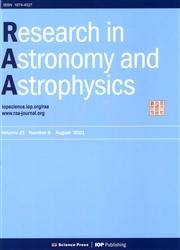最强耀斑发生前太阳活动区磁通量出现情况的统计研究
IF 2.8
4区 物理与天体物理
Q3 ASTRONOMY & ASTROPHYSICS
引用次数: 0
摘要
利用太阳周期 23 和 24 的磁场图和波连续强度数据,我们探索了 100 个产生 M5.0 或更强耀斑的活动区(ARs)。我们重点研究了这些活动区在强耀斑发生前2-3天是否出现磁通。我们发现,样本中有29个AR是在静日中单调出现的。在另外24个样本中,我们观测到在一个已经存在的AR中出现了新的磁通量,并形成了一个复杂的产生耀斑的构型。在 30 个 AR 中,观测到在原已存在的磁构型中出现了微不足道的新磁通量(就原已存在的 AR 的总磁通量而言);其中一些新磁通量的出现导致形成了一个带有小型 δ 太阳黑子的构型;在 100 个 AR 中,有 11 个在整个观测期间没有显示出磁通量出现的迹象。在 6 个案例中,当 AR 出现在东侧边缘时,磁通出现正在进行中,因此无法对磁通出现的分类和时间进行确定。我们的结论是,最近出现的磁通量并不是 AR 强烈耀斑的必要和/或充分条件。我们将这里分析的产生耀斑的AR的流量出现率与之前研究中分析的平静耀斑AR的流量出现率进行了比较。我们发现,产生耀斑的AR往往比平静耀斑的AR显示出更快的涌现速度。本文章由计算机程序翻译,如有差异,请以英文原文为准。
A Statistical Study of Magnetic Flux Emergence in Solar Active Regions Prior to Strongest Flares
Using the data on magnetic field maps and continuum intensity for Solar Cycles 23 and 24, we explored 100 active regions (ARs) that produced M5.0 or stronger flares. We focus on the presence/absence of the emergence of magnetic flux in these ARs 2–3 days before the strong flare onset. We found that 29 ARs in the sample emerged monotonically amidst quiet-Sun. A major emergence of a new magnetic flux within a pre-existing AR yielding the formation of a complex flare-productive configuration was observed in another 24 cases. For 30 ARs, an insignificant (in terms of the total magnetic flux of pre-existing AR) emergence of a new magnetic flux within the pre-existing magnetic configuration was observed; for some of them the emergence resulted in a formation of a configuration with a small δ -sunspot; 11 out of 100 ARs exhibited no signatures of magnetic flux emergence during the entire interval of observation. In six cases the emergence was in progress when the AR appeared on the Eastern limb, so that the classification and timing of emergence were not possible. We conclude that the recent flux emergence is not a necessary and/or sufficient condition for strong flaring of an AR. The flux emergence rate of flare-productive ARs analyzed here was compared with that of flare-quiet ARs analyzed in our previous studies. We revealed that the flare-productive ARs tend to display faster emergence than the flare-quiet ones do.
求助全文
通过发布文献求助,成功后即可免费获取论文全文。
去求助
来源期刊

Research in Astronomy and Astrophysics
地学天文-天文与天体物理
CiteScore
3.20
自引率
16.70%
发文量
2599
审稿时长
6.0 months
期刊介绍:
Research in Astronomy and Astrophysics (RAA) is an international journal publishing original research papers and reviews across all branches of astronomy and astrophysics, with a particular interest in the following topics:
-large-scale structure of universe formation and evolution of galaxies-
high-energy and cataclysmic processes in astrophysics-
formation and evolution of stars-
astrogeodynamics-
solar magnetic activity and heliogeospace environments-
dynamics of celestial bodies in the solar system and artificial bodies-
space observation and exploration-
new astronomical techniques and methods
 求助内容:
求助内容: 应助结果提醒方式:
应助结果提醒方式:


